Ornamentations in Indian classical dance
Make-up and ornamentations relate to Aharya Abhinaya as Rangabhusa aspect.
Although Aharya is of
 minor
importance in comparison with the aspects of Angika, Sattvika and Vachika
Abhinayas, it acts as an additional means for intensifying the visual
performance of the aesthetical aspect. At the same time the use of make-up and
ornamentations as well as the use of stage scenery and flowers varies depending
on vritti (type) and dharmi (form of a performance). For instance, Natyashastra,
a treatise on the art of drama, ascribes certain ornamentations for men and
women. minor
importance in comparison with the aspects of Angika, Sattvika and Vachika
Abhinayas, it acts as an additional means for intensifying the visual
performance of the aesthetical aspect. At the same time the use of make-up and
ornamentations as well as the use of stage scenery and flowers varies depending
on vritti (type) and dharmi (form of a performance). For instance, Natyashastra,
a treatise on the art of drama, ascribes certain ornamentations for men and
women.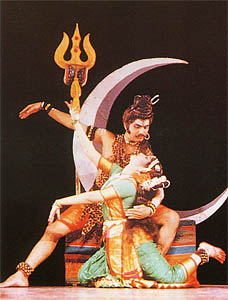
Women Siddhi must perform in yellow saris and ornamentations made of pearls and
emeralds. Actors playing Apsars (celestial dancers) use ornamentations as
ornamental patterns made of jewels and arrange their hair in a high coiffure.
Dancers portraying Gandharvas (celestial musicians) decorate themselves with
rubies and perform in bright red costumes. In their hands they must hold Vina
(the Goddess' Sarasvati's string musical instrument).
Vidyadharis must appear before the audience in white costumes decorated with
pearls. Dark garments and blue stones serve as the
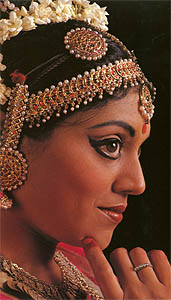 decoration
for dancers playing demonesses. The costumes made of green silk and
ornamentations made of pearls are typical for portraying goddesses. The costumes
of milk carriers must be of blue color and their hair must be plaid. decoration
for dancers playing demonesses. The costumes made of green silk and
ornamentations made of pearls are typical for portraying goddesses. The costumes
of milk carriers must be of blue color and their hair must be plaid.
Color gamut is used to tell one personages from the others. So the Kshatriys (warriors)
perform in reddish and rust-colored shades, the Vayshyas (merchants) and the
Shudras (servants) perform in darker shades.
The impeccable white is destined for the Brahmans.
The symbolism of color, costumes, make-up and ornamentations is the additional
external means for dancers to resort to in order to portray this or that image,
a hero or a heroine or a character.
Ornamentations play a special role. Dancers of classic styles Bharatanatyam,
Kuchipudi, and Mohiniattam wear the so-called temple ornamentations made of gold
and jewels. Nowadays jewels are replaced with artificial stones. The
traditionality of a temple set of ornamentation remains up to now. Every element
of ornamentation has its name and symbolism.
Chandra-prabha (the Moon) and Surya-prabha (the Sun) which are fixed on the left
(the Moon) and the right (the Sun) sides of the hair parting with the purpose of
endowing a dancer with their beauty and shining.
Talay-saaman or Chutti emphasize the line of forehead and hair parting.
Talay-saaman with Surya and Chandra
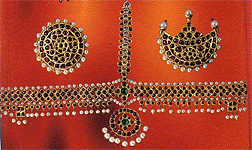
Chutti

Maatal (pendants) are fixed to the ear lobes and hair in order to cover cochleae.
They protect a dancer's hearing from the loud sound of drums.
Maatal

A long necklace is called differently depending on style and tradition:
Maanga-malay, Muthu-malay, Tanmani and Kantha-haaram in the Kuchipudi tradition.
Its purpose is to balance a dancer's breathing.
Tanmani (long necklace)
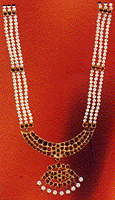
Addikai (short necklace)

A belt around the waist supports the spinal column and also has different names:
Oddiyanam, Kamar-patta, Vaddanamu in Kuchipudi.
Kamar-patta

Bracelets Valayal protect wrists and add elegance and grace to them.
Valayal

Chalang or a ring in a nose also plays a special role. A full set consists of
three kinds: a small nail or a clip for the right nostril, a ring decorated with
jewels for the left nostril (in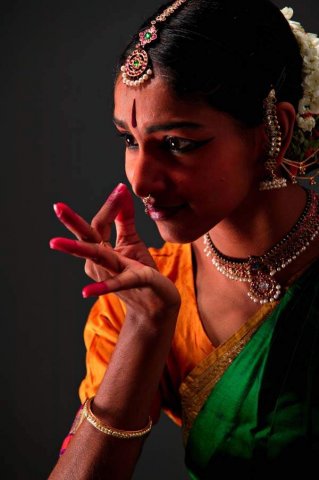 Kuchipudi it is called Mukkera) and a pendant that is fixed on the lower part of
the nasal septum.
Kuchipudi it is called Mukkera) and a pendant that is fixed on the lower part of
the nasal septum.
In the Kuchipudi tradition a certain dance episode from the drama Bhama Kalapam
is dedicated to this type of
 ornamentation.
The central personage of the drama, Satyabhama, treated her collection of
ornamentations with the great awe because she had a separate set for each day of
the week. The most precious among them was a ring Mukkera. Once after the
quarrel her beloved Lord Krishna left Satyabhama. She turned to her friend
Madhavi for help in returning Krishna's love. Satyabhama offered to give all her
ornamentations but did not desire to part with Mukkera. Madhavi kept on
insisting that Satyabhama gave her the ring. Her intention was not to take
possession of the ring but to make her friend part with her most precious
treasure. Here Satyabhama's ornamentation is compared with ego. By giving the
ring she as if gets rid of the ego's heavy bonds. It is easy to give what
belongs to you but the giving will be full only when you step over your ego. The
drama finishes in Satyabhama's giving the ring to Madhavi and Krishna returns to
her after getting the proof of her complete devotion to him. The ring's purpose
is to protect innocence. ornamentation.
The central personage of the drama, Satyabhama, treated her collection of
ornamentations with the great awe because she had a separate set for each day of
the week. The most precious among them was a ring Mukkera. Once after the
quarrel her beloved Lord Krishna left Satyabhama. She turned to her friend
Madhavi for help in returning Krishna's love. Satyabhama offered to give all her
ornamentations but did not desire to part with Mukkera. Madhavi kept on
insisting that Satyabhama gave her the ring. Her intention was not to take
possession of the ring but to make her friend part with her most precious
treasure. Here Satyabhama's ornamentation is compared with ego. By giving the
ring she as if gets rid of the ego's heavy bonds. It is easy to give what
belongs to you but the giving will be full only when you step over your ego. The
drama finishes in Satyabhama's giving the ring to Madhavi and Krishna returns to
her after getting the proof of her complete devotion to him. The ring's purpose
is to protect innocence.
Other ornamentations:
Jimmiki (earrings) or Kundalu in Kuchipudi.
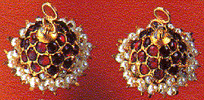
Bells - Gunghru, Gajjelu or Kinkini. They help to beat the rhythm and protect
ankles.
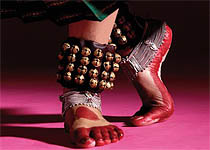
Flowers of jasmine (white) and orange Kanakambaram.
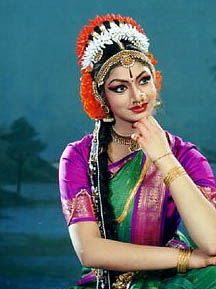
Raakodi - an ornamentation for the false hair decorated with a broche and a
braid.
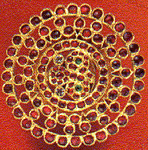
Kunjalam - an ornamentation entwined with a plait with pompons or tassels on
edges.
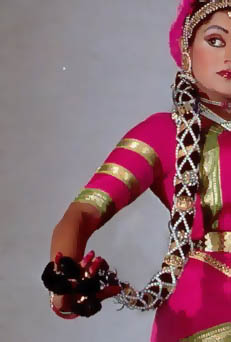
| 